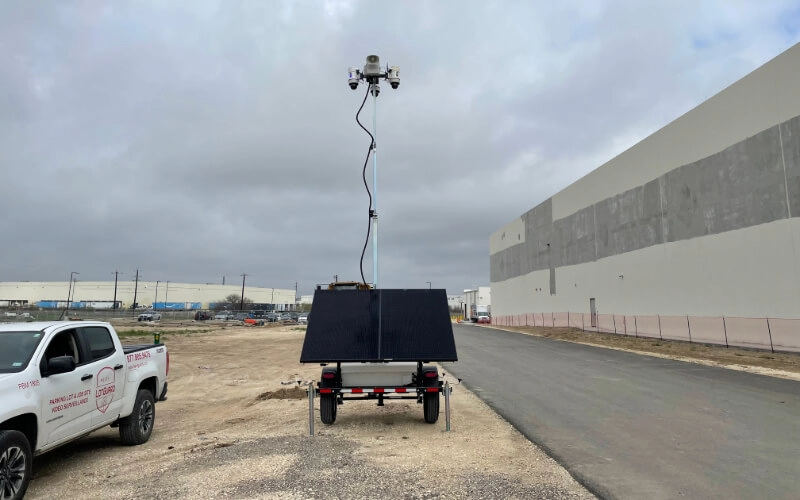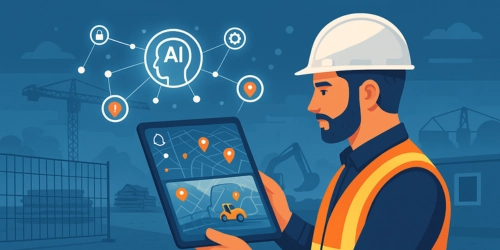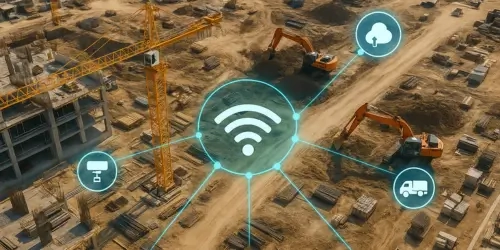It’s 7 AM and the site’s barely awake, but you already know what’s happening right from your phone. You can see the crew clocking in, the equipment status, and even the wind conditions that might affect crane lifts later that morning.
That’s what smart technology makes possible right now.
The construction industry thrives on planning and precision. And over the past few years, it’s entered a new era powered by artificial intelligence (AI), automation, and real-time insights.
In this article, we’ll explore how tech is transforming construction, improving safety, reducing downtime, and streamlining compliance. We’ll also look at how connected systems are helping teams make faster, smarter decisions, no matter where they are.
From Reactive to Predictive Construction Jobsites
For decades, construction jobsites have relied on supervisors walking the site, cameras streaming footage to control rooms, and reports filed long after incidents occurred. It worked, but it was reactive. By the time something went wrong, it was already too late to prevent it.
Today, smart technology is turning construction security into living systems that can sense, respond, and adapt on the spot. Instead of waiting for someone to notice an issue, these systems identify risks as they happen, whether that’s trespass, metal theft, or natural disasters that pose safety risks.
This shift replaces manual work and redefines how decisions are made. With real-time data, managers gain the kind of visibility that lets them act early. The result is:
-
Fewer delays
-
Fewer incidents
-
A more efficient use of both time and labor
The 4 Essential Components of a Smart Construction Jobsite
The goal of a smart construction jobsite is to know exactly what’s happening, without waiting for reports or relying on guesswork.
1. IoT and Connected Systems
Internet of Things (IoT) links cameras, sensors, and monitoring devices into a shared digital network. These connected systems collect data and interpret it in real-time.
For instance, a sudden rise in noise levels or a spike in temperature can trigger automatic alerts, prompting site managers to take corrective actions. This digital transformation enables construction teams to make smarter, faster decisions based on what’s happening in real-time.
2. Solar Surveillance Trailers
One of the most practical examples of IoT in action is the solar surveillance trailer.
These mobile units deliver instant, off-grid video security. Each unit runs on solar panels with battery storage (no fixed power or internet required) and sets up in minutes.
Standing up to 20-foot tall, the system’s telescopic mast offers wide-area visibility, featuring high-definition thermal cameras that offer a near-360 view. Cellular connectivity keeps the video feed live and accessible from anywhere, while lights, sirens, and loudspeakers deter intruders.

3. Pole Cameras
Pole cameras are especially effective for monitoring access points, storage areas, and site perimeters on construction jobsites. Because they’re portable and wireless, teams can reposition them as projects grow or risks shift.
Despite their smaller footprint, these cameras feature high-definition PTZ (Pan-Tilt-Zoom) capabilities, built-in infrared for night visibility, and onboard storage for continuous recording. Cellular connectivity ensures live and recorded footage, while AI analytics filter out false alarms from movement caused by wildlife or weather.
4. Smart Detection Systems
Smart detection systems improve jobsite safety and compliance by using AI to spot specific risks, not just motion. For example, PPE detection and monitoring automatically flag when workers aren’t wearing the required gear, like hard hats or high-visibility vests. Supervisors receive instant alerts, helping them correct issues before they turn into serious safety violations.
Meanwhile, smoke and fire detection tools identify early-stage incidents faster than traditional sensors, using AI to analyze video feeds for subtle signs of danger. When it comes to intrusion detection, your site perimeter is constantly under intelligent watch, filtering out false triggers such as animals or wind-blown debris while instantly notifying monitoring teams when real threats appear.
Environmental Monitoring and Compliance
Along with site protection, construction project managers also need to prove they’re meeting environmental and safety standards. That’s where environmental monitoring solutions add another layer of intelligence.
Air Quality Monitoring
Air quality monitoring sensors capture detailed readings for PM1, PM2.5, and PM10 particulates, along with CO₂, carbon monoxide, humidity, and volatile organic compounds (VOCs).
This live data allows teams to instantly spot changes in air quality and take corrective action before they become health or compliance concerns. Every reading is logged and time-stamped, helping you create transparent records for internal audits or external inspections.
Noise Monitoring
Noise is one of the most common causes of construction complaints, and one of the easiest to control with noise monitoring sensors. These systems continuously track sound levels, measuring ambient decibels (dB) across active zones.
When noise levels exceed defined thresholds, custom alerts notify managers, allowing quick adjustments to operations before they breach local limits. All data is stored with timestamps and video context, so if a complaint ever arises, you have verifiable evidence.
Weather Monitoring
High temperatures, unexpected lightning or heavy rainfall can halt operations in seconds, or worse, compromise safety. Weather monitoring stations provide live tracking of lightning strikes, wind speed, humidity, temperature, and rainfall across your jobsite.
These real-time alerts help managers make informed calls on when to pause work or protect assets. Lightning detection, in particular, provides early warnings that prevent accidents and support severe weather protocols.
The Benefits of Smart Construction Technology
The business benefits of smart jobsite systems are tangible:
- Fewer incidents
- Reduced costs
- Faster decision-making
- Stronger control over day-to-day operations
Smart construction approaches, particularly in mobile surveillance, have proven to be a game-changer for construction companies in terms of both security and budgets.
By combining autonomous surveillance trailers, pole cameras, and remote monitoring, many construction firms have seen their security costs drop by up to 88% compared to relying solely on traditional methods, like security guards. Cameras don’t need breaks, they never lose focus, and they can detect and deter incidents in real-time, all while capturing clear evidence for investigations.
Beyond financials, these systems strengthen accountability across every level of a project. Supervisors can verify compliance remotely, and safety teams can review incidents instantly. On top of that, project managers can track operations without stepping away from other priorities.
Smart technology aids both efficiency and peace of mind. Behind every live alert, every automated report, and every connected device lies one intelligent network that powers it all: Stellifii.
Read more: How Smart Monitoring Saves Construction Jobsites Money
Stellifii: The Platform Powering It All
Stellifii is our in-house platform that unites WCCTV's mobile surveillance, smart detection, and environmental monitoring into one cloud-based solution. It’s a single hub where your live video, diagnostics, and reports work together seamlessly; no more switching between suppliers or systems.
Here's what Stellifii delivers:
| Feature | What it means for you |
| Complete oversight during the day | Access live feeds, system diagnostics, air quality data, weather, and noise levels all from one dashboard. |
| Automated protection at night | AI-powered intruder detection verifies and escalates alerts instantly with no downtime or blind spots. |
| Faster, smarter decisions | One login gives you clear dashboards, search tools, and automated reports for audits and compliance. |
| Effortless deployment | No software installs or IT setup. Connects instantly over 4G/5G for real-time visibility anywhere. |
| Secure by design | Built on approved infrastructure with AES256 encryption and NDAA-compliant components. |
Our WCCTV engineers, developers, and monitoring specialists work side by side to ensure every feature functions exactly as intended and evolves as your projects do. Unlike third-party platforms, it isn’t retrofitted to our hardware, but rather forms the foundation of it.
The Future of Smart Construction
The construction industry is evolving fast, and the ones leading the change are those who leverage smart technology to simplify and strengthen every project. With WCCTV, that innovation comes fully connected.
Discover how Stellifii can transform your next project. Contact WCCTV today and see what a truly smart jobsite looks like.
FAQs
How is smart construction transforming the building industry with technology?
Smart construction is transforming the building industry through digital technologies like AI, IoT, and data analytics. These tools automate routine tasks, improve site visibility, and enhance safety, solving long-standing industry challenges such as low productivity, budget overruns, and safety concerns.
What key technologies are driving smart construction?
The key technologies driving smart construction include IoT, AI, machine learning, and smart sensors. Together, they enable real-time data collection, predictive maintenance, and smarter decision-making across construction projects of all sizes.
How do smart construction technologies improve the entire building process?
Modern smart construction technologies like Building Information Modeling (BIM), IoT, and advanced construction technology are redefining how projects are built and managed. They enhance data collection and analysis, streamline building components coordination, and support facility management after completion.
What does the future of smart construction look like?
The future of smart construction lies in the deeper integration of digital transformation, connected devices, and smart building solutions. As construction companies adopt AI, robotics, and drones, they’ll achieve more efficient builds, lower environmental impact, and greater resilience for future projects.




